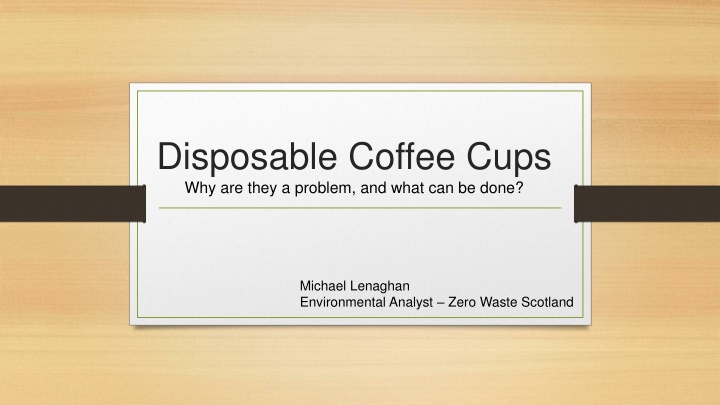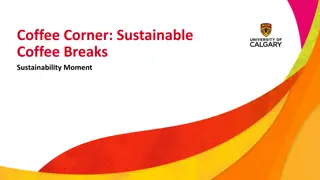The Environmental Impact of Disposable Coffee Cups
Disposable coffee cups pose a significant environmental problem due to their composition, carbon footprint, and high usage rates. The challenges in managing their waste include difficulties in recycling due to the multiple materials used, lack of proper facilities, and economic barriers. Strategies such as promoting reuse through discounts, implementing charges, and focusing on prevention can help address this issue. The annual use of disposable cups in Scotland alone contributes to a substantial amount of waste and carbon emissions, highlighting the urgent need for sustainable solutions.
Download Presentation

Please find below an Image/Link to download the presentation.
The content on the website is provided AS IS for your information and personal use only. It may not be sold, licensed, or shared on other websites without obtaining consent from the author.If you encounter any issues during the download, it is possible that the publisher has removed the file from their server.
You are allowed to download the files provided on this website for personal or commercial use, subject to the condition that they are used lawfully. All files are the property of their respective owners.
The content on the website is provided AS IS for your information and personal use only. It may not be sold, licensed, or shared on other websites without obtaining consent from the author.
E N D
Presentation Transcript
Disposable Coffee Cups Why are they a problem, and what can be done? Michael Lenaghan Environmental Analyst Zero Waste Scotland
Disposable Coffee Cups (DCCs) Presentation Overview 1. The Scale of the DCC Problem 2. Managing DCC Waste 1. Why is recycling so difficult? 2. Biodegradable: a good idea that isn t working 3. Prevention via Reuse 1. Reusable Cup Discounts 2. The Importance of Convenience 3. DCC Charges
The Problem Material Composition Avg. DCC weighs 15g 20g and is made of multiple materials: Internal waterproof lining Polyethylene (~0.1g) Cup Body Paper (~12g) Sleeve Corrugated Cardboard (~3g) Lid High Impact Polystyrene (~3g)
The Problem Carbon Impacts Producing a DCC generates ~1.5Xs its weight in CO2e, most from plastic Material Mass (18 grams) Material Impacts (28 gCO2e) 1% 1% 17% 38% 17% 51% 66% 10% Lid Sleeve Cup Body Cup Lining Lid Sleeve Cup Body Cup Lining
The Problem Annual DCC Use in Scotland Number of DCCs/yr in UK 2,500,000,000 8% Scotland s share of UK population Est. no. of DCCs/yr in Scotland 200,000,000 Tonnes of DCCs/year (avg. weight of 18g) 3,600 Production tCO2e (avg. 28gCO2e/DCC) 5,600 But this is only part of the story
Managing DCC Waste Why can t we recycle them? Internal waterproof lining Polyethylene (~0.1g) Cup Body Paper (~12g) Sleeve Corrugated Cardboard (~3g) Lid High Impact Polystyrene (~3g)
Managing DCC Waste Why can t we recycle them? Technical Barrier Requires special facility. Only 2 in the UK, neither of which are in Scotland. Internal waterproof lining Polyethylene (~0.1g) Economic Barriers DCCs are high volume, low weight, low value material that produce a low value Recyclate. Recycling DCCs over great distance is not economical. Insufficient supply to justify a plant in Scotland.
Managing DCC Waste Accounting for Waste Management Impacts The vast majority of DCCs end up in landfill, or incineration. Total est. carbon impacts: 7,000 tCO2e/year in Scotland Waste Impacts (~7g/DCC) Lifecycle Impacts (35gCO2e/DCC) 7% 20% 80% 93% Paper Plastic Production Waste Management
Managing DCC Waste Biodegradable Cups: A good idea that isn t working Very few biodegradable cups are making it to compost Waste Contractor: AD or Compost? Sort-line recognition? Access to Organic Bins? Consumer Recognition? Compostable Biodegradable Compost Facility Landfill
An ounce of prevention is worth a pound of cure - Benjamin Franklin
Prevention via Reuse Reusable Cup Discounts Nearly every major caf chain offers a reusable cup discount of some kind Starbucks: 25p Costa: 25p Pret a Manger: 25p Caf Nero: double stamps (~25p) ~10% Price Reduction So does this mean they work?
Prevention via Reuse The Starbucks Story 2008 Starbucks reusable cup rate was <2%. The company set a goal of achieving 25% by 2015. Reusable cups in store Reusable cup discount 2011 Reuse rate was still below <2%. Company lowered its goal to 5%. 1 reusable cup Trialled 50p discount 2015 Starbucks failed to achieve its objective. Reusable cup rate remained <2%.
Prevention via Reuse Reusable Cup Discounts Speaking before UK Parliaments Environmental Audit Committee (10/10/2017) [ ] people are being offered up to as much as 50 pence to use a reusable and we do have an example of one group who not only gave the cup away for nothing, they also gave you free coffee the next time you brought it in. [ ] three weeks later [ ] the ratio of reusables to regular paper coffee cups, returned to the former pattern. - Martin Kersh, Foodservice Packaging Association Discounts are not necessarily driving the levels that you would hope to see [ ]. The take-up is low [ ] below 1%. - Oliver Rosevear, Costa Coffee
Prevention via Reuse Reusable Cup Discounts If Discounts don t work, why are they so common? Impact Major retailers admit that discounts have failed to significantly increase reuse rates Vs. Image As a PR measure, discounts are an effective way to signal a company is doing its part for the environment. So what does work?
Prevention via Reuse The importance of convenience Reuse rates tend to be higher in workplaces, regardless of discount value Convenience - cleaning, storing and using a reusable cup is easier at work, than in general. An element of social capital and accountability? Reusable Cup Rates: High Street vs. Workplace 81% 40% 0.25 0.25 0.25 0.25 24% 0.20 13% 0.12 12% 11% 10% 10% 8% 0.06 6% 3% 2% 2% 1% Starbucks Costa Org 1 Org 2 Org 3 Org 4 Org 5 High Street Workplaces Discount Value % Savings (Medium Americano) Reusable Cup Rate
Prevention via Reuse The Importance of Convenience Urban Deposit Return System How do they work? Customers pay a deposit for a reusable cup, which they can keep or return to a participating retailer at any time to recoup their deposit. The cup is then cleaned and reintegrated into the system. Benefits Consumers get the convenience of a DCC without the environmental impacts. Sharing Economy - reduces net demand for reusable cups. Real world examples? Commonly used at Christmas Markets throughout the UK City of Hamburg Refill It! System launched in 2016 Cup Club UK start-up, just won $2m Circular Design Fund from Ellen MacArthur Foundation
Prevention via Reuse Charging for Disposable Coffee Cups Packaging is NOT free We all pay for packaging - the cost is simply hidden from view. ~7% of your grocery bill is for the cost of packaging Packaging charges and discounts make the cost of packaging explicit. Charges vs Discounts Loss Aversion - charges are more effective than discounts at changing behaviour, because they harness what is known in behavioural science as loss aversion People will do more to avoid loss than they will to obtain gain. Scotland s 5p Carrier Bag Charge A minor charge reduced single-use carrier bag use by 80% (ZWS, 2014) Would the results have been the same if shoppers were offered a 5p discount on their bill for each reusable bag they used?
Prevention via Reuse Charging for Disposable Coffee Cups A DCC Charge is a simple way to change consumer behaviour without raising costs Reusable Cup Discount System DCC Charge System Drink served in DCC Drink Cost 1 0.90 DCC Charge 0 0.10 Total Cost with DCC 1.00 1.00 Drink served in Reusable Cup Drink Cost 1 0.90 Reusable Cup Discount - 0.10 0 Total Cost with Reusable Cup 0.90 0.90 There is an inverse tax already, is there not? If you are prepared to give a 25 pence discount, that is already a charge. - Environmental Audit Committee Chair (10/10/17)
Prevention via Reuse Charging for Disposable Coffee Cups The public and policy-makers have expressed an interest in a DCC Charge September 2017 Scottish Government announces it will, establishing an advisory group to consider fiscal and other measures to reduce waste and boost the circular economy for example, a possible levy on single use coffee cups . (The Government s Programme for Scotland 2017-2018) October 2017 YouGov Survey on behalf of Marine Conservation Society found 74% of Brits would support a charge on single use coffee cups . October 2017 - UK Parliament s Environmental Audit Committee held oral evidence session on exclusively on the issue of coffee cup waste during which a charge is a central topic of discussion.
Prevention via Reuse Charging for Disposable Coffee Cups The Packaging Industry strongly opposes a DCC charge, arguing: 1) We should focus on reducing litter, rather than prevention charges will not address litter problems [ ] the necessary transformation in consumer behaviour in relation to litter will require investment in national, behaviour change-led programmes. - Paper Cup Recovery and Recycling Group, Packaging News. a charge on cups will not in any way change the behaviour of those who feel it s acceptable to litter. Foodservice Packaging Association (FPA), Packaging News. 2) We should focus on recycling, rather than prevention The focus should be in building on the good work that has been implemented to recover and recycle coffee cups. FPA, Packaging News. We are not, as an industry, in favour of bans and charges. What we want to do is to put the infrastructure and the points into place so that people can recycle the product. FPA s Martin Kersh speaking to Environmental Audit Committee
Prevention via Reuse Charging for Disposable Coffee Cups The Packaging Industry strongly opposes to a DCC charge (cont.): 3) Reducing DCC waste would be bad for the economy the focus should not be in reducing demand for an industry that makes a positive contribution to the economy. FPA, Packaging News. In other words, preventing waste reduces economic activity. Conversely, encouraging waste stimulates the economy. Imagine making the same argument about energy efficiency, or food waste.
Conclusion Scotland generates ~2 million DCCs a year DCCs are difficult to recycle due to their material composition Preventing DCCs through reuse is the best way to reduce their environmental impacts Reusable cup discounts are a common, but ineffective incentive The are used to communicate environmental commitment What works Making reusable cups more convenient Replacing reusable cup discounts with DCC charges The public supports a DCC Charge the packaging industry does not. Now to Dr. Poortinga who will present results from his field study
Thank You Michael Lenaghan Environmental Analyst Zero Waste Scotland michael.Lenaghan@zerowastescotland.org.uk























